Boning Knife Guide
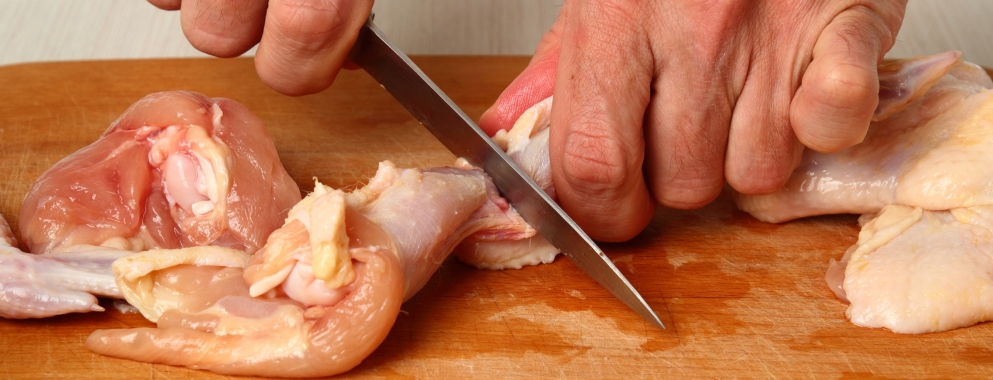
- Best boning knives
- How to choose a boning knife
- Stiff V Flexible blades
- Can you use a boning knife for filleting?
- How to clean a boning knife
- Boning knife price guides
- Sets including boning knives
- Top Tips for Nose-to-Tail Cooking
Boning knives have long, thin, flexible blades with a sharp tip to make piercing meat easier and safer. The blade is designed to cut through ligaments and connective tissue to remove raw meat from the bone.
Boning knives have to be extremely sharp, and the tougher the blade, the longer it will maintain its sharpness. Dull blades can rip meat from the bone rather than slicing it, which affects both cooking and presentation.
Dull knives are dangerous as they require more force to cut through meat, meaning you can easily lose control of the knife.
Best boning knives
Below are three of the best boning knives for your kitchen:
Victorinox Fibrox Boning Knife 15cm (£11.73)
 Best for: Beef, lamb, pork, fish, poultry and game birds
Best for: Beef, lamb, pork, fish, poultry and game birds
The thin, flexible blade of this boning knife makes it a perfect all-rounder. The high-carbon stainless-steel blade is ice-tempered to ensure the bladeit is as sharp as possible and will retain its sharpness. The comfortable handle is made from Fibrox plastic and is slip resistant, making it highly safe.
Shun Classic Boning Knife 15cm (£96.47)
 Best for: Beef, lamb, pork and venison
Best for: Beef, lamb, pork and venison
The stainless steel full tang blade is clad in 16 layers of VG10 high-carbon steel making it extremely durable and razor sharp. The ‘D’-shaped handle is made from beautiful pakkawood and is designed to fit the shape of the hand.
Global G21 Boning Knife 16cm (£83.29)
 Best for: Fish, poultry and game birds
Best for: Fish, poultry and game birds
The flexible, fine blade of this boning knife makes filleting fish and boning chicken easy but the blade is strong enough to handle game and pork as well. The weighted, hollow handle features dimples to improve grip and has a hollow handle for the perfect balance. The knife and handle are made from one piece of stainless steel which means there is no chance of the knife breaking at the bolster when cutting through particularly tough areas.
How to choose a boning knife
The type of boning knife you use will largely depend on the job it is needed for and type of meat you will be handling. When choosing a boning knife, you will have the following options:
Design of blade:
- Curved. The curve of a fillet or boning knife is excellent at removing fish skin in one swipe, as well as making long, clean strokes through the flesh. This shape can also make some delicate jobs, such as filleting a quail, easier as the angle of the curve allows for more effective manoeuvrability around small spaces.
- Straight. This is easier for removing large chunks of meat, such as beef. Interestingly, many traditional Japanese fillet knives are straight. The straight blade is said to help with finer slicing and sculpting. In the hands of an expert, these knives are ideal for high-speed cuts.
- Flexible. The ability to blend and flex is better for intricate jobs as it allows the knife to cut round lighter corners and difficult shapes.
- Stiff. Tougher, thicker meat and cause a less robust knife to flex and go off course. Stiff blades can be used to cut through and portion off wide cuts.
- Thin. Not all thin blades are necessarily flexible. Sometimes, thinner blades are needed for cutting around smaller angles. Thinner blades also travel through the flesh with less resistance, causing less harm to more delicate meat.
- Broad. Wide, sturdy knives are essential for portioning thick sections of meat.
Size:
This will depend on the type of meat being cut.
Handle:
- Handles. Handles need to be comfortable in your hand. However, some jobs require a firm a grip when force is required to bear down on the meat, while others will be used more like a scalpel to make precision incisions.
- Tang. This refers to the thin piece of metal that runs through the handle of a knife. It is the same metal that makes up the blade and is continuous. Full tang means the metal runs to the end of the handle, which is then constructed around it. This is a more secure handle than partial tang handles, in which metals stops halfway up. Some knives are made entirely from one continuous piece of metal, including the handle. These are particularly robust.
- Material. Wooden handles look very stylish but can warp when left in water. Metal handles are hardy but some people find them cold and less secure. A good all-round material is polypropylene. This synthetic hard plastic can have the appearance of wood without any of the maintenance issues.
Stiff V Flexible blades
|
Blade Type |
Application |
Typical blade Size |
Typical blade Style |
|
Stiff |
Thicker cuts of beef, pork and saltwater fish. Will separate bones from meat and remove fat and connective tissue. |
Larger blade 16.5cm - 22.5cm |
Straight blade |
|
Flexible |
Tender cuts and delicate work like deboning and removing skin from fish and poultry. |
Smaller blade 12.5cm - 16.5cm |
Curved blade |
Can you use a boning knife for filleting?
Technically, a fillet knife is a type of boning knife — one that is used to remove the bones of fish. Due to the variability in shape and design of both boning and filleting knives, many can be used for both purposes. The flexibility that is typical of many boning knives means they are well suited for use on fish. However, the lighter fillet knives may not so well on thick joints of beef or venison.
How to clean a boning knife
Like with most kitchen knives, it is best to clean and dry your knives by hand immediately after use. Even though most knives are made from stainless steel and therefore fairly resistant to rust, water can swell and warp wooden handles, seep into cracks — risking hygiene, and deteriorate the chromium coating that protects against rust.
For more information on how to care for your kitchen knives, click here.
Boning knife price guides
You will find that there is a wide range of prices for boning knives. Which knife you choose will depend on the purpose to which it will be put and the frequency of use. For chefs working in a busy kitchen, it’s important to invest in a quality boning knife due to the precision and strength needed to bone and fillet safely.
|
Image |
Knife |
Specifications |
Best used for |
Blade |
Price * |
 |
15cm. Stainless steel. Full-tang handle with flared bolster. 25-year guarantee. |
Poultry and fish. |
Flexible |
||
 |
16cm. Cromova 18 stainless steel. Hollow handle. |
Beef, lamb, pork, large salt water fish. |
Stiff |
||
 |
14cm. Stainless steel. Classic three-rivet design. |
Poultry and fish. |
Flexible |
||
 |
13cm. Moulded polypropylene handle. |
Poultry and small fish. |
Flexible |
||
 |
15cm. Chromium molybdenum steel. Full tang. |
Poultry and fish. |
Flexible |
||
 |
13cm. Stainless steel. Moulded handle. |
Poultry and fish. |
Flexible |
||
 |
14cm. Full tang. Classic three-rivet moulded handle. |
Lamb, pork, poultry. |
Semi-flexible |
||
 |
15cm. Cromova 18 stainless steel. Hollow handle. |
Beef, lamb, pork. |
Stiff |
||
 |
12cm. Stainless steel. Fibrox handle. |
Poultry. |
Flexible |
||
 |
15cm. Stainless steel. Fibrox handle. |
Fish and poultry. |
Flexible |
||
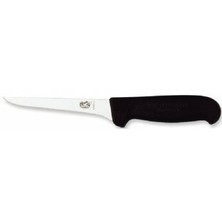 |
12cm. Stainless steel. Fibrox handle. |
Small fish and poultry. |
Flexible |
||
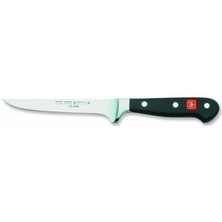 |
14cm. Full tang. High stainless carbon steel. |
Beef, lamb, pork poultry, game birds and fish. |
Semi-flexible |
||
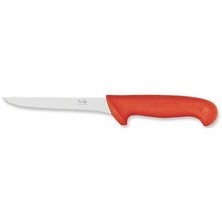 |
15cm. Coloured handle for specific use. |
Fish, poultry. |
Flexible |
||
 |
17m. Laminated steel blade. Stays sharp for long. |
Beef, lamb, pork and venison. |
Stiff |
||
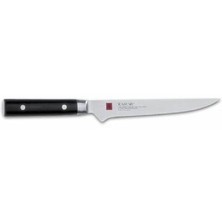 |
16cm. Damascus-style blade made from V Gold No 10 high carbon stainless steel and hardened to Rockwell C59-60. |
Beef, lamb, pork, fish, poultry and game. |
Stiff |
Sets including boning knives
Boning knives don’t usually feature in standard knife sets as they are specialist butchering and filleting blades. However, at Russums we stock a number of knife sets for professionals which include boning knives. Below are low, medium and high price range options:
- Smithfield Knife Set Large With 23cm Cooks Knife In Cotton Wallet - £62.46
- Victorinox Knife Set Large With 25cm Cooks Knife In KC210 Case - £109.58
- Global 30th Anniversary Knife Set 9 Piece - £333.32
Top Tips for Nose-to-Tail Cooking
The nose-to-tail trend of cooking and eating an entire animal has seen an increase in chefs brushing up on their butchery skills. Couple this with the current popularity of more unusual cuts of meat, and it offers a good reason for taking a look at the knives in your kitchen to see if they are up to the task.
There are a number of good reasons why you might want to start butchering your meat in-house:
- You know what you’re getting. Checking the background of an animal that you have sourced yourself is much easier than attempting to research every little cut you may purchase separately.
- Trying new parts of an animal. With the prevalence of TV shows like MasterChef and the Great British Menu, people are increasingly eager to try the rarer parts of an animal, be it the neck, cheek, feet or some of the more unusual organs.
- You have more control over what you cook. This is one way of getting the exact cut you’re after, be it thick, thin, fatty or lean.
- It’s often cheaper. Butchery costs money. You only have to look at the cost of chicken fillets compared with a whole chicken to realise the mark-up that is placed on separate cuts.

If you want to embrace the nose-to-tail eating trend in your establishment but aren’t sure how to get started, here are some of the more popular choices among customers in today’s restaurants:
- Cheek. A delicious and tender cut. Some diners may be put off by the fact that it’s part of an animal’s face but it’s a versatile piece of meat that is both lean and tender. Slowed-cooked ox cheek is increasingly popular, while cured pork cheek is the traditional ingredient in carbonara.
- Sweetbreads. For those who like their offal, ‘sweetbreads’ are actually edible parts of the thymus gland and pancreas. They can be soaked in water to remove any impurities and then fried in a pan with some butter.
- Lamb fries.Fries, or testicles, are often sliced in half and fried in a hot pan. Not to be confused with ‘lamb’s fry’, which in many parts of the world refers to various types of lamb offal such as heart, kidney, sweetbreads and especially liver.
- Trotters. Another tender cut. Boil first until the meat almost falls off the bone, then cover with a glaze and roast.
- Tripe. This edible stomach lining can be used in sausages, put in a stew, or simply pickled.
- Bone marrow.Increasingly popular and highly nutritious. Can be served in the bone or scooped out and used in a broth, or simply on toast.
- Pig ears.These can add a meaty crunch to dishes. They require boiling beforehand to get the cartilage soft enough to eat.
- Gelatine. The sticky element to meat, you can harvest this by boiling down bones and cartilage and then use it to thicken up a stew or as part of a dessert.
- Fat. You can produce richly flavoured lard by rendering excess fat yourself. The process involves adding water to stop the fat from burning, and then straining the resultant liquid.
Take a look at some of the other knives on offer at Russums, or contact us to find out more. To read some more useful information about knives, following these links:
10 Most Common Chef Knife Care Mistakes and How to Stop Making Them
Guide to Sushi and Sashimi Knives
Frequently Asked Questions About Granton Edge Blades
Guide to Carving and Slicing Knives
Santoku Knives vs Chefs Knives
Know Your Carving Knife History
9 June 2016





